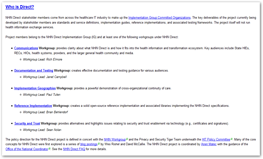Occasionally I update news on this project but you may or may not be familiar with the NHIN. This is an initiative for the exchange of healthcare information under the direction of the ONC to bring together HIE (health information exchanges), pharmacies, lab, providers, payers and others in healthcare to be able to communicate in a secure manner. This is both a government/private venture as there are foundations already that have contributed both money, time and effort.
This is to ensure that EHRs and PHRS as well as payers and others will have use of healthcare data on shared subsets of data. Consumers and providers of course will have access, and as it looks now, those patients with a PHR will have more access than just the basic portal. There is also a site called NHIN Direct with those listed working on the project. They do have a Twitter feed but don’t get too excited as there’s not a lot there except links to reports, etc.
From the website:
- Project members belong to the NHIN Direct Implementation Group (IG)
 and at least one of the following workgroups under NHIN Direct:
and at least one of the following workgroups under NHIN Direct: - Communications Workgroup: provides clarity about what NHIN Direct is and how it fits into the health information and transformation ecosystem. Key audiences include State HIEs, RECs, HIOs, health systems, providers, and the larger general health community and media.
- Workgroup Lead: Rich Elmore
- Documentation and Testing Workgroup: creates effective documentation and testing guidance for various audiences.
- Workgroup Lead: Janet Campbell
- Implementation Geographies Workgroup: provides a powerful demonstration of cross-organizational continuity of care.
- Workgroup Lead: Paul Tuten
- Reference Implementation Workgroup: creates a solid open-source reference implementation and associated libraries implementing the NHIN Direct specifications.
- Workgroup Lead: Brian Behlendorf
- Security and Trust Workgroup: provides alternatives and highlights issues relating to security and trust enablement via technology (e.g., certificates and signatures).
- Workgroup Lead: Sean Nolan
If you look at the last name on the security list we see Sean Nolan from Microsoft on this committee, good place for Microsoft to be I think. I won’t bore you too much with the details on the common levels of standards that will come into play here as if you are a casual reader you probably have no idea and if you are one working on a current HIE project you may not be able to stand hearing a lot more on this topic by reading this post since you get it everywhere else.
Back to the nuts and bolts of this post, Lockheed with their contract will be creating a working model to test and see if all this connectivity with relative standards will work. In short this is somewhat meant to be the “grand daddy” aggregator of health data no matter where it comes from so there’s a lot of work to be done and we are still at the baby stages right now with hospitals talking with other hospitals and then doctors too.
Instead of this method though we could all jus resolve ourselves to have a chip implanted that contains all our medical data <grin> but that’s only half the battle in reality as studies and other information will be included in the network, that is if it works. A meltdown though of an exchange this side would be a million times worse data wise though than Wall Street and I say that to demonstrate the magnitude of what this project is. It is also possible that I may never see the completion of this in my lifetime too as there will be new technologies that come out and new algorithms and systems so this will be a roller coaster ride for sure.
Right now with transparency we are seeing some real data issue with errors and information that is not accurate in systems, and that goes back a number of years and some of it was just simple data input mistakes so there’s a lot clean up that goes with all of this too. BD
The Office of the National Coordinator awarded $9 million in contracts to Lockheed Martin Corp. to create real-world models of the nationwide health information network (NHIN) in order to demonstrate its features and hasten its use by prospective health care offices.
The IT integrator will set up demonstration Web sites to test NHIN technology and standards as well as the interaction of network components required for secure health information exchange.
“This is the equivalent of taking a new medical therapy out of a controlled clinical trial and assessing the value of that therapy in a real-world setting,” said Michael Leff, director of Lockheed’s Health Information Management Solutions group in announcing the work on Aug. 25.ONC has lined up other contracts to move the NHIN forward Earlier this month, it awarded about $20 million in NHIN work to Stanley, an IT services provider, to build a standards database with related tools to enable their reuse and to manage the network’s testing infrastructure.



![image[15] image[15]](http://lh5.ggpht.com/_v3zjJigoAPE/THhyaiy-sII/AAAAAAAAg4Y/YFX6jEhMGYI/image%5B15%5D%5B5%5D.png?imgmax=800)

0 comments :
Post a Comment